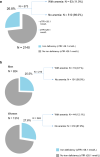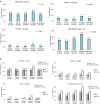Prevalence and incidence of iron deficiency in European community-dwelling older adults: an observational analysis of the DO-HEALTH trial
- PMID: 35304704
- PMCID: PMC9464157
- DOI: 10.1007/s40520-022-02093-0
Prevalence and incidence of iron deficiency in European community-dwelling older adults: an observational analysis of the DO-HEALTH trial
Abstract
Background and aim: Iron deficiency is associated with increased morbidity and mortality in older adults. However, data on its prevalence and incidence among older adults is limited. The aim of this study was to investigate the prevalence and incidence of iron deficiency in European community-dwelling older adults aged ≥ 70 years.
Methods: Secondary analysis of the DO-HEALTH trial, a 3-year clinical trial including 2157 community-dwelling adults aged ≥ 70 years from Austria, France, Germany, Portugal and Switzerland. Iron deficiency was defined as soluble transferrin receptor (sTfR) > 28.1 nmol/L. Prevalence and incidence rate (IR) of iron deficiency per 100 person-years were examined overall and stratified by sex, age group, and country. Sensitivity analysis for three commonly used definitions of iron deficiency (ferritin < 45 μg/L, ferritin < 30 μg/L, and sTfR-ferritin index > 1.5) were also performed.
Results: Out of 2157 participants, 2141 had sTfR measured at baseline (mean age 74.9 years; 61.5% women). The prevalence of iron deficiency at baseline was 26.8%, and did not differ by sex, but by age (35.6% in age group ≥ 80, 29.3% in age group 75-79, 23.2% in age group 70-74); P < 0.0001) and country (P = 0.02), with the highest prevalence in Portugal (34.5%) and the lowest in France (24.4%). As for the other definitions of iron deficiency, the prevalence ranged from 4.2% for ferritin < 30 µg/L to 35.3% for sTfR-ferritin index > 1.5. Occurrences of iron deficiency were observed with IR per 100 person-years of 9.2 (95% CI 8.3-10.1) and did not significantly differ by sex or age group. The highest IR per 100 person-years was observed in Austria (20.8, 95% CI 16.1-26.9), the lowest in Germany (6.1, 95% CI 4.7-8.0). Regarding the other definitions of iron deficiency, the IR per 100 person-years was 4.5 (95% CI 4.0-4.9) for ferritin < 45 µg/L, 2.4 (95% CI 2.2-2.7) for ferritin < 30 µg/L, and 12.2 (95% CI 11.0-13.5) for sTfR-ferritin index > 1.5.
Conclusions: Iron deficiency is frequent among relatively healthy European older adults, with people aged ≥ 80 years and residence in Austria and Portugal associated with the highest risk.
Keywords: Community-dwelling older adults; Europe; Incidence; Iron deficiency; Prevalence.
© 2022. The Author(s).
Conflict of interest statement
HABF received as the PI of this study independent and investigator-initiated funding by Vifor Pharma. LAA is currently an employee of MSD, Switzerland. DRS’s academic department is receiving grant support from the Swiss National Science Foundation, Berne, Switzerland, the Swiss Society of Anesthesiology and Reanimation (SGAR), Berne, Switzerland, the Swiss Foundation for Anesthesia Research, Zurich, Switzerland, Vifor SA, Villars-sur-Glâne, Switzerland and Vifor (International) AG, St. Gallen, Switzerland. DRS is co-chair of the ABC-Trauma Faculty, sponsored by unrestricted educational grants from Novo Nordisk Health Care AG, Zurich, Switzerland, CSL Behring GmbH, Marburg, Germany, LFB Biomédicaments, Courtaboeuf Cedex, France and Octapharma AG, Lachen, Switzerland. DRS received honoraria / travel support for consulting or lecturing from: Danube University of Krems, Austria, US Department of Defense, Washington, USA, European Society of Anesthesiology, Brussels, BE, Korean Society for Patient Blood Management, Seoul, Korea, Korean Society of Anesthesiologists, Seoul, Korea, Network for the Advancement of Patient Blood Management, Haemostasis and Thrombosis, Paris, France, Alexion Pharmaceuticals Inc., Boston, MA, Baxalta Switzerland AG, Volketswil, Switzerland, Bayer AG, Zürich, Switzerland, B. Braun Melsungen AG, Melsungen, Germany, Boehringer Ingelheim GmbH, Basel, Switzerland, Bristol-Myers-Squibb, Rueil-Malmaison Cedex, France and Baar, Switzerland, CSL Behring GmbH, Hattersheim am Main, Germany and Berne, Switzerland, Celgene International II Sàrl, Couvet, Switzerland, Daiichi Sankyo AG, Thalwil, Switzerland, Haemonetics, Braintree, MA, USA, Instrumentation Laboratory (Werfen), Bedford, MA, USA, LFB Biomédicaments, Courtaboeuf Cedex, France, Merck Sharp & Dohme, Kenilworth, New Jersey, USA, Novo Nordisk Health Care AG, Zurich, Switzerland, PAION Deutschland GmbH, Aachen, Germany, Pharmacosmos A/S, Holbaek, Denmark, Pfizer AG, Zürich, Switzerland, Pierre Fabre Pharma, Alschwil, Switzerland, Portola Schweiz GmbH, Aarau, Switzerland, Roche Diagnostics International Ltd, Reinach, Switzerland, Sarstedt AG & Co., Sevelen, Switzerland and Nümbrecht, Germany, Shire Switzerland GmbH, Zug, Switzerland, Tem International GmbH, Munich, Germany, Vifor Pharma, Munich, Germany, Neuilly sur Seine, France and Villars-sur-Glâne, Switzerland, Vifor (International) AG, St. Gallen, Switzerland, Zuellig Pharma Holdings, Singapore, Singapore.
Figures


References
-
- World Health Organization (2008) Worldwide prevalence of anaemia 1993–2005: WHO global database on anaemia. World Health Organization. http://www.who.int/iris/handle/10665/43894. Accessed 21 March 2021
-
- Berger J, Dillon JC. Control of iron deficiency in developing countries. Sante. 2002;12:22–30. - PubMed
Publication types
MeSH terms
Substances
Grants and funding
LinkOut - more resources
Full Text Sources
Research Materials

